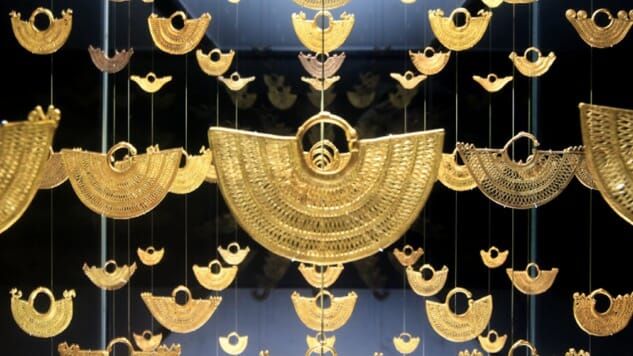From Alabama to Colombia: The Legend of El Dorado and Inaugural Day

The ceremony sounds like some fantastic vision induced by ayahuasca, the powerful Colombian hallucinogen.
High in the Andes, a new cacique, or chieftain, of the Muisca people stepped onto a wooden raft at the weedy edge of an unusually round, green lake. Around him on the raft stood worthy warriors bearing tribal banners.
Impossibly, the new leader glowed, a shining man covered from head to toe with gold dust. He also wore an elaborate headdress of feathers, a gold nose ring, and adornments for his ears.
The raft pushed off into what the Spanish conquistadores would one day call Lago de Guatavita (Lake Guatavita). For the indigenous Muiscas, the lake was sacred. The immersion ceremony honored the life goddess of water, Chie.
As the raft slowly moved toward the center of the circular lake (many Colombians believe it’s a flooded meteor crater), the chief spread his hands wide … and scattered emeralds over the sparkling water.
At the center of the lake, the raft came to a stop.
The golden chief approached the raft’s edge, paused, then plunged into the water. The gold dust washed off his body, an offering to the goddess, and the spiritual event bound him and his tribe to her blessings.
A visitor to Colombia can’t fully understand this nation—or really the entire post-Columbus history of the Americas—without understanding the legend that arose from this ceremony.
The Spanish arrived in South America in the 16th century and soon grew fevered by tales of El Dorado, The Golden One. The more times the conquistadores told and retold the story, the bigger it grew. The golden king became a golden town. The golden town became a city of gold. The legend traveled by ship to the Old World, where it catalyzed exploration and settlement of the new one.
Fired by lust for precious metals, soldiers with steel armor and gunpowder poured into Colombia and all the rest of the Americas. They took no prisoners. By some estimates, more than 80 percent of the native peoples, including the Muiscas, died within a generation of their first encounters with Europeans. Smallpox and Spanish weapons proved more powerful than the goodness of goddesses.
The Spanish did find gold in Guatavita. Lots of it. Phillip II filled royal coffers with shiploads of loot, Muisca treasures melted into ingots and doubloons. The Spaniards tried more than once to drain the entire emerald lake, finally giving up when they realized it probably cost more than the gold and jewels they stood to recover.
-

-

-

-

-

-

-

-

-

-

-

-

-

-

-

-

-

-

-

-

-

-

-

-

-

-

-

-

-

-

-

-

-

-

-

-

-

-

-

-








































